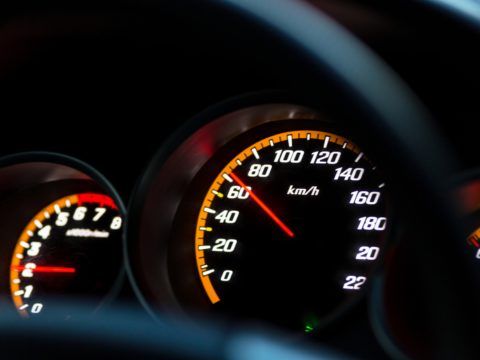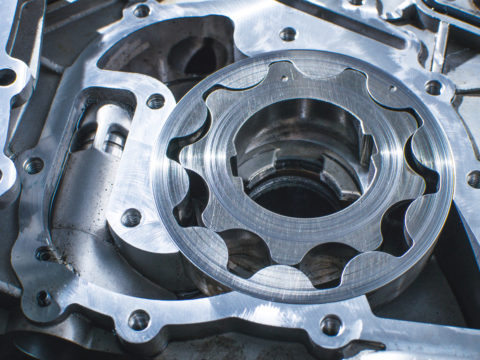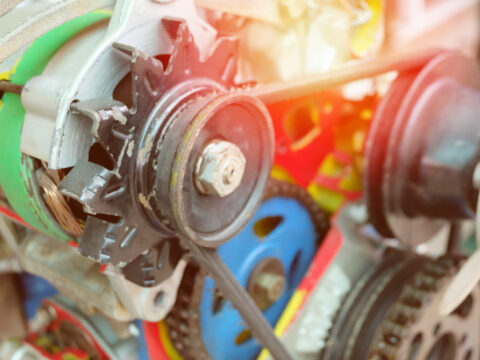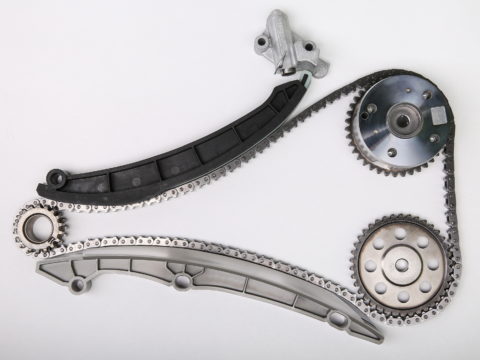If you’ve ever found yourself wondering what would happen if you put gas into a diesel engine, you’ve come to the right place for answers. We’ll go over what happens and ways to remedy such an issue.
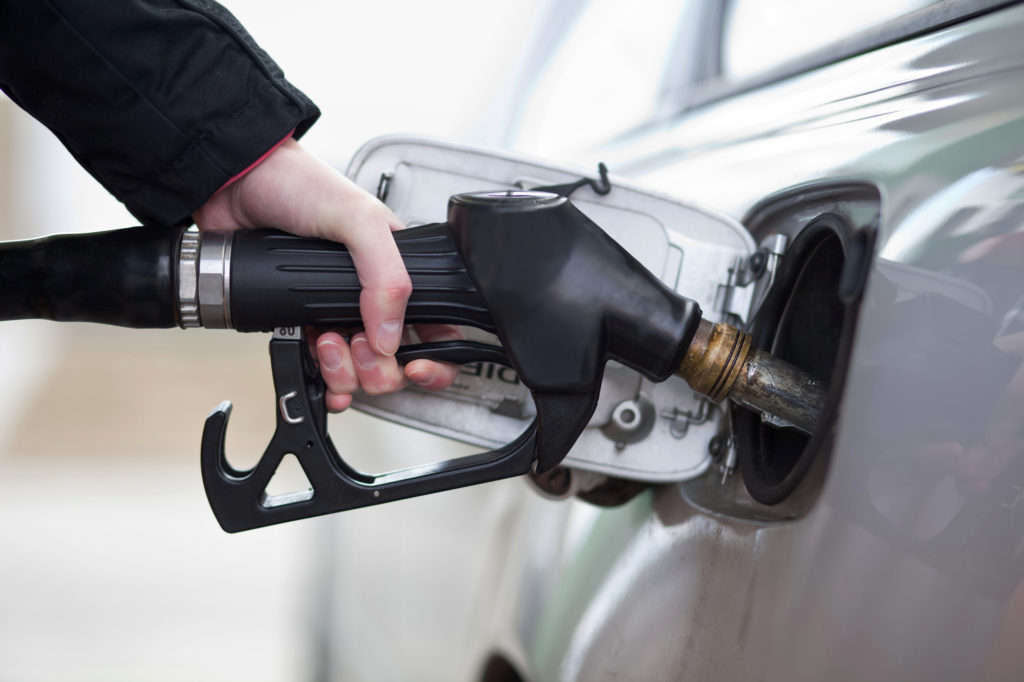
Contents
The Difference Between Gas Engine and a Diesel Engine
There are a few differences between gas engines and diesel engines, both in terms of their design and performance. Some of the differences are somewhat superfluous, but there are fundamental ones worth knowing for various reasons.
Gasoline Engine Overview
A gasoline engine is a type of engine that uses internal combustion and spark-ignition. The ignition and combustion of the fuel are what give the engine the necessary energy to move the pistons and rotate the crankshaft of a vehicle. This in turn is what makes the wheels of a vehicle move.
Diesel Engine Overview
Like gasoline engines, diesel engines also use an internal combustion system. However, where gasoline engines use the spark-ignition, diesel engines use compression-ignited injection. In this system, you have the diesel fuel push into the engine’s combustion chamber, where it meets with extremely hot temperatures that ignite it.
How To Identify Petrol and Diesel
The simplest way to identify petrol from diesel is by color. The color of diesel is clear or slightly green, whereas petrol is usually either light red or light green. You can also determine which one is which by the density because petrol is not as dense as diesel.
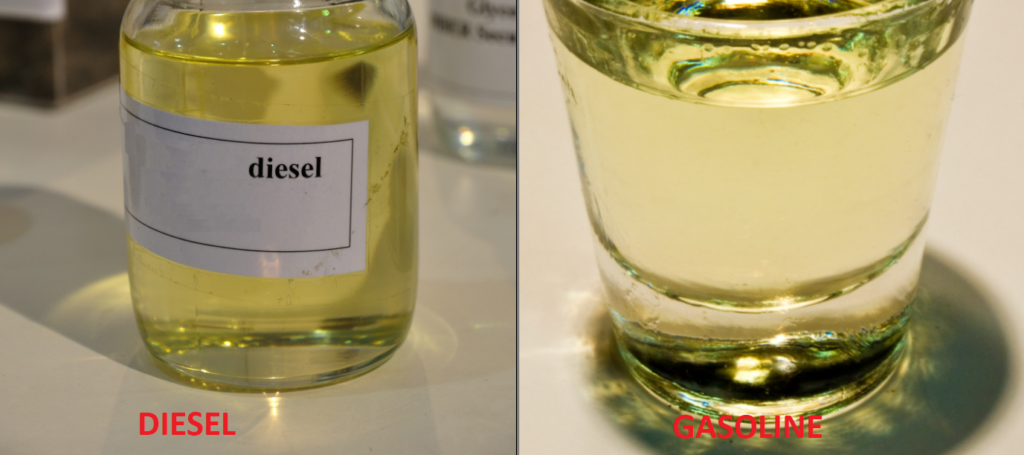
You can even test with your finger and see how fast the liquid evaporates on your finger. Diesel will last for a while, whereas petrol will evaporate relatively fast.
Petrol In Diesel Car Symptoms
Here are some symptoms you can watch for if you think there is petrol in your diesel car.
1) Loud Engine Noise
Because diesel engines do not support petrol, you’ll probably be quick to notice that something does not sound right once you start driving if there is petrol in your car. And if you are outside the vehicle when it is running, it will be impossible to miss the change in sound to your engine.
2) Engine Warning Light Comes On
Now, while the engine warning light coming on can suggest a whole host of issues, none of which are pleasant, one of those potential issues is petrol being in the engine. Hopefully, this is the first symptom that you’ll see, as it at least confirms something is malfunctioning in the engine that you need to address. Even if it is not necessarily petrol causing issues.
3) Engine Shuts Off Completely And Fails To Start
If your diesel engine suffers enough damage from petrol being in it, then there is a chance that it will shut off without warning. If this occurs, you can attempt to start the engine again to see if the ignition will work. However, there is a strong chance that it will not because the damage to the engine is already too significant.
4) Inconsistent Acceleration
Having petrol in a diesel engine will reduce the engine’s ability to function correctly in many areas, and one of these areas is acceleration. When you attempt to accelerate, you will encounter a jerking or stuttering effect that makes it difficult for your car to get going and maintain good speed.
5) Smoke Coming From The Exhaust
Having smoke come from your vehicle’s exhaust is never a good sign, and it can mean that there is petrol in your diesel engine. If you don’t see smoke, you can also place your hand on your vehicle’s hood to gauge the temperature. It is not a good sign if it feels unnaturally hot, though it is not quite as bad as seeing smoke.
What To Do If You Put Gas In a Diesel Engine?
Hopefully, you will never find yourself in a situation where gas somehow makes its way into your diesel car. However, if you do, here are some suggestions to help remedy the issue as best as possible.
1) Don’t Panic
Above all else, do not panic. Yes, realizing that you have put gas into a diesel engine is an awful and frustrating experience, but losing your cool over it will only worsen the situation. Instead, keep calm and follow the below steps.
2) Do Not Start The Car
If you realize that there is gas in your car after you’re already driving, there is little about the situation that can get worse. Though if you’re lucky enough to realize what you did and still have yet to start your car, then that means the gas has not had an opportunity to work its way through your car’s system yet. So, your situation is more than salvageable.
3) Remove The Key From The Ignition
It is a good idea to remove the key from the ignition to be extra cautious. Having it in the ignition will tell your car’s engine that it is ready to drive, meaning that the gas can begin making its way through the system, which again, is just about the last thing you want in this situation.
4) Try To Assess How Much Gas Made Its Way Into The Vehicle
While challenging to do if you are not standing at a gas station and looking directly at the readings, knowing how much gas got into your diesel engine is helpful.
Of course, any amount of gas is bad for the engine, but if there is only a small amount of gas then you’ll likely avoid having to replace any parts. Whereas if the tank is full of gas, you’ll have some serious work to do.
5) Empty and Clean Out The Fuel Tank
After assessing the situation, you will need to remove all the gas from the engine as quickly as possible. You can either do this yourself or have a towing company take your car to an automobile repair shop and have it done by professionals.
6) Replace The Fuel Filter
Replacing the fuel filter is a must if you put gas into your diesel car, and luckily, a new fuel filter is not super expensive. The individual part can cost between $15 and $70. However, if you plan to have a certified mechanic install the part at a repair shop, then expect to pay upwards of $100, though this does vary depending on the shop.
7) Clean The Fuel Lines
Assuming your car’s fuel lines in the undercarriage do not sustain significant damage, you can keep on using them, but not before undergoing a thorough cleaning. For this, you can use whatever brand of brake cleaner you prefer. Just make sure you clean the fuel lines thoroughly and check to ensure there is zero gas still in them once you finish.
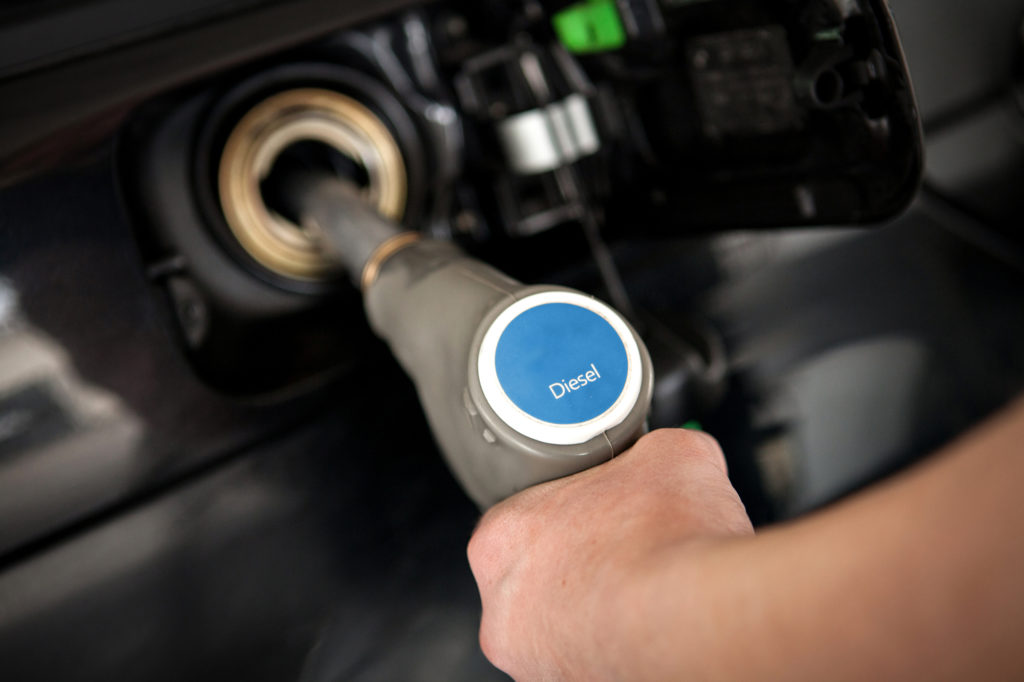
How To Drain Gas Out Of a Diesel Tank
Now, let’s go over how to drain the gas out of a diesel tank.
Tools And Equipment Needed
Not all fuel tanks are directly drainable, but if your car’s tank is, all you will need to drain it are your hands, a socket wrench, and something to catch the gas.
Locate The Fuel Tank
First, locate your car’s fuel tank. You will likely find it at the bottom of your vehicle, though its position does differ between vehicles. To make your life easy, use the manufacturer manual that came with your car to locate the tank.
Locate the Drain Plug And Remove It
Once you find the tank, place a pan or something that can catch the falling gas beneath the drain plug. You can then remove the drain plug by unscrewing it with the socket wrench and letting gravity do the rest of the work.
Drain The Gas
The time it takes for all the gas to drain will depend on how much is currently in the tank. If there is a lot, make sure that whatever you use to catch the gas is large enough to hold it all. In fact, you will probably want to have multiple pans or bowls on hand to catch the gas.
Reattach The Drain Plug
After all the gas is out of the tank, reattach the drain plug and screw it back into place. And be sure to screw it back on nice and tight, as you don’t want it to pop off later.
Petrol in Diesel Engine Cost Of Repair
It is difficult to give an accurate cost for the repairs you might need after putting petrol in a diesel engine because the extent of the damage can vary significantly. In the worst-case scenario where your car will need several new parts and a professional will be the one replacing them, you can easily spend around $1000.
Your best bet is to get an estimate from a repair shop you trust and then compare that with prices from other shops.
FAQ
Here are some answers to a few questions you may still have.
How Much Gasoline In a Diesel Tank Is Too Much
The answer is any. Even a drop of gas in a diesel tank will have negative effects that can turn severe. So, always be sure to carefully read the labels at a gas station before pumping fuel into your car.
How Far Can You Drive With Petrol In a Diesel Car?
You may cover a decent few meters of ground with your car or perhaps even a little more. However, you will not get far before seeing some of the symptoms we went over earlier, or the engine shuts off entirely.
Which Is Worse Gas In Diesel Or Diesel In Gas?
Putting gas in a diesel engine is arguably worse than putting diesel in a gas engine, though both situations are equally perilous in terms of how much you should avoid them. The two types of engines have different combustion properties, so they need their specific types of fuel at the end of the day.
What If I Accidentally Put Petrol In a Diesel Car By Mistake And Drove It?
If you drive your car after accidentally putting petrol in it, stop driving as soon as possible and contact a towing company. You will want to tow your vehicle to an automobile repair shop you trust and have them flush all the petrol from your car’s fuel system before checking for damage.

